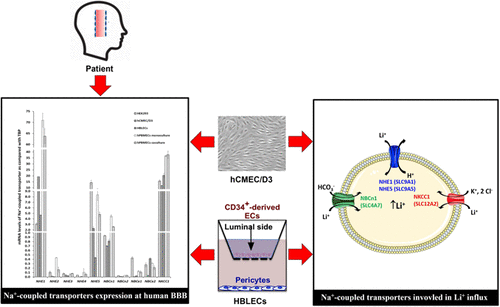当前位置:
X-MOL 学术
›
Mol. Pharmaceutics
›
论文详情
Our official English website, www.x-mol.net, welcomes your feedback! (Note: you will need to create a separate account there.)
Sodium Transporters Are Involved in Lithium Influx in Brain Endothelial Cells
Molecular Pharmaceutics ( IF 4.9 ) Pub Date : 2018-06-07 00:00:00 , DOI: 10.1021/acs.molpharmaceut.8b00018 Huilong Luo 1, 2 , Matthieu Gauthier 1, 2 , Xi Tan 1, 2 , Christophe Landry 3 , Joël Poupon 4 , Marie-Pierre Dehouck 3 , Fabien Gosselet 3 , Nicolas Perrière 5 , Frank Bellivier 1, 6 , Salvatore Cisternino 1, 2 , Xavier Declèves 1, 2
Molecular Pharmaceutics ( IF 4.9 ) Pub Date : 2018-06-07 00:00:00 , DOI: 10.1021/acs.molpharmaceut.8b00018 Huilong Luo 1, 2 , Matthieu Gauthier 1, 2 , Xi Tan 1, 2 , Christophe Landry 3 , Joël Poupon 4 , Marie-Pierre Dehouck 3 , Fabien Gosselet 3 , Nicolas Perrière 5 , Frank Bellivier 1, 6 , Salvatore Cisternino 1, 2 , Xavier Declèves 1, 2
Affiliation

|
Variability in drug response to lithium (Li+) is poorly understood and significant, as only 40% of patients with bipolar disorder highly respond to Li+. Li+ can be transported by sodium (Na+) transporters in kidney tubules or red blood cells, but its transport has not been investigated at the blood–brain barrier (BBB). Inhibition and/or transcriptomic strategies for Na+ transporters such as NHE (SLC9), NBC (SLC4), and NKCC (SLC12) were used to assess their role on Li+ transport in human brain endothelial cells. Na+-free buffer was also used to examine Na+/Li+ countertransport (NLCT) activity. The BBB permeability of Li+ evaluated in the rat was 2% that of diazepam, a high passive diffusion lipophilic compound. Gene expression of several Na+ transporters was determined in hCMEC/D3 cells, human hematopoietic stem-cell-derived BBB models (HBLEC), and human primary brain microvascular endothelial cells (hPBMECs) and showed the following rank order with close expression profile: NHE1 > NKCC1 > NHE5 > NBCn1, while NHE2–4, NBCn2, and NBCe1–2 were barely detected. Li+ influx in hCMEC/D3 cells was increased in Na+-free buffer by 3.3-fold, while depletion of chloride or bicarbonate had no effect. DMA (NHE inhibitor), DIDS (anionic carriers inhibitor), and bumetanide (NKCC inhibitor) decreased Li+ uptake significantly in hCMEC/D3 by 52, 51, and 47%, respectively, while S0859 (NBC inhibitor) increased Li+ influx 2.3-fold. Zoniporide (NHE1 inhibitor) and siRNA against NHE1 had no effect on Li+ influx in hCMEC/D3 cells. Our study shows that NHE1 and/or NHE5, NBCn1, and NKCC1 may play a significant role in the transport of Li+ through the plasma membrane of brain endothelial cells.
中文翻译:

钠转运蛋白参与脑内皮细胞的锂内流
人们对锂(Li +)药物反应的变异性了解甚少且意义重大,因为只有40%的躁郁症患者对Li +高度反应。Li +可以通过肾小管或红细胞中的钠(Na +)转运蛋白转运,但尚未在血脑屏障(BBB)上研究其转运。Na +转运蛋白(如NHE(SLC9),NBC(SLC4)和NKCC(SLC12))的抑制和/或转录组策略用于评估其在人脑内皮细胞中对Li +转运的作用。还使用不含Na +的缓冲液来检查Na + / Li +反转运(NLCT)活动。在大鼠中评估的Li +的BBB渗透性是地西epa的2%,地西epa是一种高度被动扩散的亲脂性化合物。在hCMEC / D3细胞,人类造血干细胞衍生的BBB模型(HBLEC)和人类原代脑微血管内皮细胞(hPBMEC)中测定了几种Na +转运蛋白的基因表达,并显示了以下具有紧密表达特征的等级顺序:NHE1 > NKCC1 > NHE5 > NBCn1,而几乎未检测到NHE2-4,NBCn2和NBCe1-2。Na +中hCMEC / D3细胞的Li +内流增加不含缓冲液3.3倍,而氯化物或碳酸氢盐的消耗没有影响。DMA(NHE抑制剂),DIDS(阴离子载体抑制剂)和布美他尼(NKCC抑制剂)分别显着降低hCMEC / D3中的Li +吸收,分别降低52%,51%和47%,而S0859(NBC抑制剂)增加Li +流入2.3 -折叠。Zoniporide(NHE1抑制剂)和针对NHE1的siRNA对hCMEC / D3细胞的Li +内流没有影响。我们的研究表明,NHE1和/或NHE5,NBCn1和NKCC1可能在Li +通过脑内皮细胞质膜的运输中起重要作用。
更新日期:2018-06-07
中文翻译:

钠转运蛋白参与脑内皮细胞的锂内流
人们对锂(Li +)药物反应的变异性了解甚少且意义重大,因为只有40%的躁郁症患者对Li +高度反应。Li +可以通过肾小管或红细胞中的钠(Na +)转运蛋白转运,但尚未在血脑屏障(BBB)上研究其转运。Na +转运蛋白(如NHE(SLC9),NBC(SLC4)和NKCC(SLC12))的抑制和/或转录组策略用于评估其在人脑内皮细胞中对Li +转运的作用。还使用不含Na +的缓冲液来检查Na + / Li +反转运(NLCT)活动。在大鼠中评估的Li +的BBB渗透性是地西epa的2%,地西epa是一种高度被动扩散的亲脂性化合物。在hCMEC / D3细胞,人类造血干细胞衍生的BBB模型(HBLEC)和人类原代脑微血管内皮细胞(hPBMEC)中测定了几种Na +转运蛋白的基因表达,并显示了以下具有紧密表达特征的等级顺序:NHE1 > NKCC1 > NHE5 > NBCn1,而几乎未检测到NHE2-4,NBCn2和NBCe1-2。Na +中hCMEC / D3细胞的Li +内流增加不含缓冲液3.3倍,而氯化物或碳酸氢盐的消耗没有影响。DMA(NHE抑制剂),DIDS(阴离子载体抑制剂)和布美他尼(NKCC抑制剂)分别显着降低hCMEC / D3中的Li +吸收,分别降低52%,51%和47%,而S0859(NBC抑制剂)增加Li +流入2.3 -折叠。Zoniporide(NHE1抑制剂)和针对NHE1的siRNA对hCMEC / D3细胞的Li +内流没有影响。我们的研究表明,NHE1和/或NHE5,NBCn1和NKCC1可能在Li +通过脑内皮细胞质膜的运输中起重要作用。



























 京公网安备 11010802027423号
京公网安备 11010802027423号